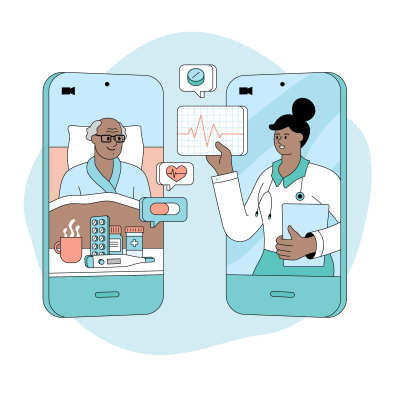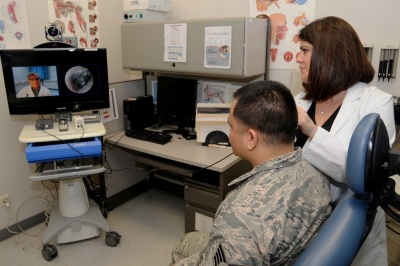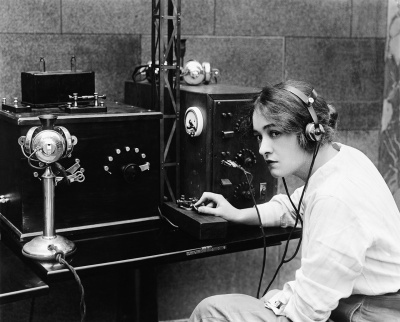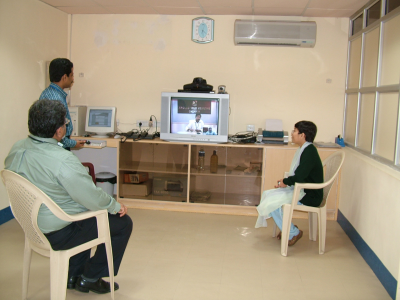Telehealth
Telehealth—often called telemedicine—refers to the systems which enable the widespread delivery and facilitation of health and health-related services between patients and healthcare providers. Such services may include but are not limited to diagnosis, monitoring, and advice [1]. Many telehealth systems are designed to allow healthcare professionals to provide superior, additional, or alternative care for patients without, or alongside, an in-person office consultation [2]. Telehealth is conducted primarily online—on computers, tablets, smartphones, and other smart devices. Smart devices allow patients to send and receive messages—via email, video chat, and secure messaging—with their doctors. This digital information allows doctors to actively manage health care from afar.
Telehealth began as a means to provide medical support when a face-to-face interaction between the providers was made difficult due to the distance, cost, or unavailability of a suitable transport. Providers seek to improve access to care for those living in remote and underserved areas [3]. Further use-cases for telehealth include those caused by patient immobility—caused by coma, paralysis, or emergency [4].
Telehealth, generally, also includes topics besides diagnosis and monitoring such as advice and reminders. The scope further expands to include a multitude of non clinical services such as preventive and promotive components and campaigns. Also included is tele-education, for patients or care providers, through distance learning, meetings, supervision, and presentations.
Goals of telehealth include decreasing physician visit frequency, decreasing healthcare cost, decreasing mortality rates, and decreasing healthcare disparities amongst communities.
Contents
History
The inequality in the availability of good healthcare between the higher and lower classes, certain ages and geographies, and other demographics has existed since the advent of healthcare.
Prior to the advent of the telephone—in 1876—those seeking remote medical attention and advice would send representatives and/or telegrams to convey information on symptoms and ailments [5]. Given this information, doctors and representatives would relay home diagnosis and treatment options. The need to communicate health information rapidly was underscored throughout the American Civil War; telegraphs were used to aid in the care of wounded soldiers, and deliver mortality information away from the front line and to the White House and beyond [6]. As early as 1879, doctors recognized the potential of remote patient care in order to avoid unnecessary house and hospital visits.
Modern telecommunication was invented following the commercialization of Alexander Graham Bell’s telephone [7]. With the ever-growing prevalence of wired communication, new relationships between patients and doctors began to form. Patients were now able to describe health issues real-time with their providers.
By 1905, doctors were able to use the telephone to transmit and monitor cardiac sounds and rhythms: increasing the utility of telehealth [8]. Radio systems on ships were able to transmit patient information long distances to doctors far from conflict zones. Video transmission of health information was pioneered in the mid 20th century, vastly improving professionals’ ability to witness and understand the scope of each case.
The ability to care for astronauts aboard Apollo 11 and other space flights was extremely important to the National Aeronautics and Space Administration [9]. Neil Armstrong, Buzz Aldrin, and other astronauts routinely reported key health information to Mission Control doctors.
Over subsequent decades, technologists enabled telehealth professionals to transmit additional medical data such as X-rays, stethoscope audio files, electrocardiograms, and many other medical tests long distances [10]. At this point, providers began veering from initial motivations: to provide support for rural and hard-to-reach populations and medical emergencies. The digitization of medical records, and wider ease of access, was understood to improve care for all [11]. Additionally, it was hypothesized that cost savings related to forgoing physical records could be passed on to consumers. Instant access to current and prior images using computers could also speed up the dissemination of information and assist with rapid and accurate diagnoses [12].
Internet use further increased participation in telehealth and rapidly altered practices: audio and images could be instantly interpreted [13]. Customized hardware and software was created to increase the ability of carers to interpret a patient's symptoms and state-of-mind. The increasing ability of various software to exchange information has both inhibited and enabled increasing standardization [14]. New technologies aim to decrease the effect of an inability to physically interact with, and touch patients.
Types
Telehealth is an umbrella term for a variety of services provided to patients in all conditions [15]. Care typically falls into four different categories: condition management, counseling and mental health therapy, patient education, and prescription refills. Specialized care is also often available.
Condition Management
While patients still require in-person consultation to gather data—including lab tests and x-rays—some clinics and practitioners provide virtual appointments and other methods of communication that enable patients to see their doctor and/or nurse routinely. Such appointments allow for ongoing and active care when a visit is not necessary, not possible and/or not desired (as seen in the COVID-19 pandemic). [16]
Counseling and Mental Health Therapy
One of the most common forms of telehealth is counseling and mental health therapy. The act of meeting with therapists, and other providers, via video chat (and other technologies), has grown exponentially in recent years, especially in light of the COVID-19 pandemic [17]. Many studies have been conducted to both prove and disprove the efficacy of such treatments. Some believe that such treatments, delivered via telehealth decreases a clinician's ability to diagnose and treat certain ailments, perhaps due to an inability to truly connect person-to-person through a computer screen. Opponents believe telehealth enables a wider segment of the population to obtain the support they desperately need and may not be able to access. Certain challenges currently being analyzed include the multitude of videoconferencing/telehealth platforms, the difficulty associated with managing client expectations, inadequate devices and/or connections, and more. The answers to such questions will, without a doubt, determine the future direction of the field and the quality of care received by some of the most vulnerable members of society. [18]
Patient Education
Many telehealth services are generally for minor illnesses, similar to the services available at a drop-in clinic when immediate medical intervention is not required.
These web-based services often guide customers through a series of questions to inform the attending healthcare professional [19]. In these informal settings, the doctor or nurse can inform patients about the nature of their malady, suggest home care strategies, or recommend additional medical care. Diagnoses are typically not generated in sessions like these.
Historically, telehealth services specializing in patient education have worked to increase awareness of sexually transmitted diseases (STDs), teen pregnancy, and many other endemic public health topics [20].
Prescription Refills
Telehealth is often used to monitor and improve ongoing health issues, such as medication changes. Rather than interact directly with doctors after an initial and in-person consultation, patients can share information concerning medication efficacy and side-effect prevalence [21]. Industry advocates believe constant and ongoing management of conditions is essential in ensuring treatment success.
Technologies
Increasingly capable technologies have developed alongside the advent and growth of eHealth, or electronic health support, and mHealth, or mobile-device centric health care. Many recent technologies have improved medical care, education opportunities, and information dissemination for all. Remote patient monitoring (RPM) technologies often remind patients to weigh themselves and transmit the measurements to their physicians. Earlier detection of complications, through additional monitoring, can help identify additional at-risk patients, deserving of additional medical attention and advice. Chronic illnesses, such as diabetes, can be more readily, efficiently and cheaply managed through the use of RPM technologies.
App Store
iOS and Android users can currently access thousands of mobile health applications which provide a variety of assistive technologies. Some allow users to track calorie intake while others provide additional tools for diabetes management. Additionally, mobile devices, and associated chat bots, allow users to schedule appointments and communicate with providers via video conference and text message. Popular applications such as Messenger, FaceTime, and Skype have recently received telehealth-use authorization from the Office of Civil Rights division within the Department of Health and Human Services.
Apple Watch
The Apple Watch, first introduced in 2015, has enabled patients to track their own measurements, set medication and appointment reminders, and share information with clinicians. Wearables and other electronic monitoring devices are being used to collect and transfer vital sign data including blood pressures, cardiac stats, oxygen levels, and respiratory rates. The capabilities of the Apple Watch continue to expand with each new generation; it has recently gained the capability to detect irregular heart patterns.
Outcomes
COVID-19
The novel coronavirus disease 2019 (COVID-19) was first reported in China, and subsequently spread globally, stressing hospitals and healthcare systems worldwide. Given the high transmissibility of COVID-19, limiting patient contact with healthcare providers has become a priority [22]. Digital logic flows have been created that refer certain patients to video visits rather than in-person visits. Such care can be conducted without exposing staff or capital to the virus; it has also allowed healthcare providers to remotely monitor the spread of the disease and the status of many patients. Telehealth has been used to ensure that providers can continue to care for established and nonexposed patients in spite of COVID-19. Between March 2019 and March 2020, the United States of America saw a 154% increase in the number of telehealth visits. By February 2020, the Centers for Disease Control specifically recommended that health care facilities and providers “offer clinical services through virtual means such as telehealth” [23].
Telehealth following 2004 Indian Ocean Earthquake
While the 2004 Indian Ocean earthquake killed more than 100,000 people across southeast Asia, it also brought about one of the largest organized telehealth campaigns since its advent. With support from the Indian government, village counseling was provided across the region for patients suffering from PTSD and other neurological disorders [24]. Volunteer counselors later remotely consulted rotating psychiatrists tasked with supporting the psychological needs of the community, and the diagnostic assistance and training required by the volunteers [25]. Patients identified to be suffering from mental health issues were also asked to remotely consult with psychiatrists. At least two suicides were proven to be prevented from “just one location, where the evaluation took place" [26].
Cost Structure
The cost and cost structure of telehealth depends on a multitude of factors, including condition, severity, insurance, and provider.
According to GoodRx Health, health plans provided by Aetna, BlueCross BlueShield, and UnitedHealthcare, shows that insurance companies have gotten on board [27]. Most will cover varying degrees of telehealth services, depending on your benefits. Both Medicare and Medicaid provide coverage for telehealth. While the plans may cover telehealth services, the extent to which they do so varies greatly depending on whether such services are “held on pre-approved video platforms” or whether they are hosted on third-party providers [28]. Significant hurdles for more wide-spread telehealth adoption are the limits on reimbursement and the inconsistent payer landscape.
Cost regulation and normalization of telehealth and telemedicine require changes from the federal level. There is no federal mandate requiring private payers to reimburse for telehealth services.
Legal and Ethical Questions
Modern technologies are changing the ways psychologists and other healthcare providers do business [29]. Such technologies have brought about a number of ethical and legal challenges and dilemmas since their advent. While many advocate for slowing the production and implementation of new technologies, in order to determine the implications of their use, others support immediate use to support explorations into new mechanisms for supporting patients around the globe [30].
Recent Policy
Recent federal policy changes about technology use now allow health care seekers to receive care using video chat programs. Non-public facing applications such as Apple FaceTime, Facebook Messenger video chat, Google Hangouts video, Zoom, or Skype are now eligible for use.
The federal government has also provided additional HIPAA flexibility for telehealth technology [31]. The U.S. Department of Health and Human Services Office for Civil Rights empowered “covered healthcare providers to use widely available communications applications without the risk of penalties imposed by the U.S. Department of Health and Human Services Office for Civil Rights” for violations of HIPAA [32].
In light of COVID-19, the federal government has also allowed for additional waivers for providers to deliver telehealth services [33]. First, the Department of Health and Human Services enabled healthcare providers to “offer telehealth services to patients located in their homes and outside of designated rural areas” [34]. The Department also expanded reimbursement programs for telehealth services.
Inadequate Treatment
A number of ethical issues have arisen surrounding the telephone’s widespread use for clinical services, as not all individuals and ailments are appropriate for intervention over telephone. Common concerns include a patient’s overconfidence in a clinician’s ability to properly assess and diagnose without in person interaction. Nuances such as pain perception, vocal inflection, temperature, and others, may not be able to be properly assessed via typical telehealth methods. General appearance, posture, and body language aid in the assessment of patients—a degradation of their visibility may negatively impact outcomes.
Crisis situations which require hospitalization or in-person treatment may present additional challenges to telehealth.
The issue of whether phone-only interactions are equivalent to in-person psychotherapy sessions, and other types of telehealth, is currently being studied. It must also be noted that for many, phone-only treatment may be the only option.
To ensure that all healthcare seekers gain access to the attention they need, and all necessary questions are covered, telehealth providers have often turned to pre-constructed scripts. While such scripts ensure that essential topics and questions are covered for all patients, discrete questionnaires have a history of crafting patients to fit solutions rather than the other way around. Furthermore, there is an expectation that any given patient has a reasonable understanding of modern technologies. Such an expectation may disincentivize patients who prefer email from joining a live-telehealth platform.
Asymmetrical Treatment
The development of telehealth policy and associated uniform professional training and practice standards has lagged behind its implementation. The Office of Civil Rights (OCR) at the Department of Health and Human Services is “responsible for enforcing certain regulations issued under the Health Insurance Portability and Accountability Act of 1996” [35]. The Department notes that “some of these technologies, and the manner in which they are used by HIPAA covered health care providers, may not fully comply with the requirements of the HIPAA Rules” [36]. With growing usage, the Office of Civil Rights has become increasingly involved in enforcing HIPAA rules and regulations, and imposes penalties for noncompliance. Implementing standards across the industry have proven difficult, with much guidance stressing maintenance of “the same standard of care as an in-person visit” [37]. Inconsistent treatment, outcomes, and experiences are common within telehealth.
Informed Consent
Informed consent is a central tenet of treatment in the healthcare system. Enforcing this accepted standard may be difficult for telehealth care professionals over the phone. Such professionals experience difficulty in determining whether an individual is competent and legally able to give informed consent over their treatment process and schedule. Comprehensive informed consent procedures are being crafted to ensure patients remain in control of their treatment.
An additional ethical consideration concerning informed consent, is that the act of getting informed consent for telehealth services is not required by every state, nor every provider, nor for every service provided. The United States Department of Health and Human Services has compiled several 'common sense' actions for a provider to implement. First, providers should describe exactly what they can expect from telehealth. Second, providers should ensure that any outside observers, live or via database, are disclosed and approved by patients. [38]
Liability
Malpractice coverage for telehealth services is in its infancy. Those treating dangerous patients or those with suicidal and/or abusive ideation may require additional licensure and additional insurance. Even still, providers may face increased exposure to legal challenges. [39]. It is recommended, by the United States Government, that telehealth operators check with insurers before offering services; liability insurance may cover telehealth claims. State laws concerning telehealth vary greatly across the United States, and it is recommended that operators explore such laws prior to offering any services. Educational programs are provided by the Rural Health Information Hub, the American Medical Association, and the National Consortium of Telehealth Resource Centers [40].
Access
Many in America, and around the world, still lack reliable and private access to phones and the internet [41]. With many healthcare providers and insurance companies adding digital telehealth options for patients, not all who require such attention will necessarily be able to get it. Outreach programs around the world, in India in particular following the 2004 Indian Ocean earthquake and tsunami, seek to alleviate this disparity. Access to mobile internet, in the United States, has been growing and 313 million people new use the internet in the country, or 90.8% [42]. While such numbers represent the majority of people in the country—networks have yet to reach every home and every person [43].
Security Flaws
Over the past many years, the National Center for Biotechnology Information has observed an increasing number of data breaches—many of which are evidenced by data collected by the Office for Civil Rights Data [44]. Modern telehealth technologies, and medial records in general, collect and aggregate data in the cloud and on many different servers. Per the Iranian Journal of Public Health, medical records of nearly 200 million people have been gathered by nefarious actors. Oversight, as it relates to the development of such applications and technologies and their associated security measures is in its infancy. This lack of oversight has the potential to expose at-risk individuals to newfound-concerns. The security of electronic records, especially those concerning personal health and well-being, is critical. Safe, actively-monitored database infrastructures, operated and maintained by governments and technology companies are currently in production [45]. The ongoing question over the credibility of the safety of digital medical records, especially those collected via telehealth, threatens to slow the growth of the field in the future—especially as consumers become increasingly aware of the size and scale of the issue of personal data safety.
References
- ↑ Rossow, Renae (August 2018). "The Different Types of Telehealth". Retrieved January 29, 2022.
- ↑ Centers for Disease Control (July 2020). "The Use of Telehealth and Telemedicine in Public Health". Retrieved January 31, 2022.
- ↑ Centers for Disease Control (July 2020). "The Use of Telehealth and Telemedicine in Public Health". Retrieved January 31, 2022.
- ↑ Rossow, Renae (August 2018). "The Different Types of Telehealth". Retrieved January 29, 2022.
- ↑ Gogia, Sashi (2020). "Rationale, history, and basics of telehealth". Retrieved January 29, 2022.
- ↑ Gogia, Sashi (2020). "Rationale, history, and basics of telehealth". Retrieved January 29, 2022.
- ↑ Gogia, Sashi (2020). "Rationale, history, and basics of telehealth". Retrieved January 29, 2022.
- ↑ Gogia, Sashi (2020). "Rationale, history, and basics of telehealth". Retrieved January 29, 2022.
- ↑ Gogia, Sashi (2020). "Rationale, history, and basics of telehealth". Retrieved January 29, 2022.
- ↑ Nesbitt, Thomas (2020). "The Evolution of Telehealth: Where Have We Been and Where Are We Going?". Retrieved January 21, 2022.
- ↑ Nesbitt, Thomas (2020). "The Evolution of Telehealth: Where Have We Been and Where Are We Going?". Retrieved January 21, 2022.
- ↑ Nesbitt, Thomas (2020). "The Evolution of Telehealth: Where Have We Been and Where Are We Going?". Retrieved January 21, 2022.
- ↑ Nesbitt, Thomas (2020). "The Evolution of Telehealth: Where Have We Been and Where Are We Going?". Retrieved January 21, 2022.
- ↑ Gogia, Sashi (2020). "Rationale, history, and basics of telehealth". Retrieved January 29, 2022.
- ↑ Centers for Disease Control (July 2020). "The Use of Telehealth and Telemedicine in Public Health". Retrieved January 31, 2022.
- ↑ Researchgate Yuqi Guo and David Albright [https://targethiv.org/sites/default/files/media/documents/2021-10/Wooton%202020%20Y2TEC%20Lessons%20Learned.pdf (March 2017) "The effectiveness of telehealth on self-management for older adults with a chronic condition: A comprehensive narrative review of the literature "]. Retrieved February 4, 2022.
- ↑ Centers for Disease Control. [https://targethiv.org/sites/default/files/media/documents/2021-10/Wooton%202020%20Y2TEC%20Lessons%20Learned.pdf (October 2020) "Overcoming Technological Challenges: Lessons Learned from a Telehealth Counseling Study"]. Retrieved February 4, 2022.
- ↑ Centers for Disease Control. [https://targethiv.org/sites/default/files/media/documents/2021-10/Wooton%202020%20Y2TEC%20Lessons%20Learned.pdf (October 2020) "Overcoming Technological Challenges: Lessons Learned from a Telehealth Counseling Study"]. Retrieved February 4, 2022.
- ↑ New England Journal of Medicine Catalyst. (February 2018) "What Is Telehealth". Retrieved February 1, 2022.
- ↑ New England Journal of Medicine Catalyst. (February 2018) "What Is Telehealth". Retrieved February 1, 2022.
- ↑ New England Journal of Medicine Catalyst. (February 2018) "What Is Telehealth". Retrieved February 1, 2022.
- ↑ The role of telehealth during COVID-19 outbreak: a systematic review based on current evidence (August 2020). "BMC Public Health". Retrieved January 28, 2022.
- ↑ Trends in the Use of Telehealth During the Emergence of the COVID-19 Pandemic — United States, January–March 2020 (March 2020). "Morbidity and Mortality Weekly Report, CDC". Retrieved January 28, 2022.
- ↑ Impact of the Tsunami on healthcare systems (September 2005). "Journal of the Royal Society of Medicine". Retrieved January 28, 2022.
- ↑ Impact of the Tsunami on healthcare systems (September 2005). "Journal of the Royal Society of Medicine". Retrieved January 28, 2022.
- ↑ Impact of the Tsunami on healthcare systems (September 2005). "Journal of the Royal Society of Medicine". Retrieved January 28, 2022.
- ↑ How Much Does a Telemedicine Visit Cost? A Price Comparison Chart (March 2020). "GoodRx Health". Retrieved January 22, 2022.
- ↑ How Much Does a Telemedicine Visit Cost? A Price Comparison Chart (March 2020). "GoodRx Health". Retrieved January 22, 2022.
- ↑ Centers for Disease Control. "Telehealth and Telemedicine: A Research Anthology of Law and Policy Resources". Retrieved February 4, 2022.
- ↑ Centers for Disease Control. "Telehealth and Telemedicine: A Research Anthology of Law and Policy Resources". Retrieved February 4, 2022.
- ↑ Manatt. "Executive Summary: Tracking Telehealth Changes State-by-State in Response to COVID-19". Retrieved February 4, 2022.
- ↑ United States Department of Health and Human Services. "Notification of Enforcement Discretion for Telehealth Remote Communications During the COVID-19 Nationwide Public Health Emergency". Retrieved February 4, 2022.
- ↑ United States Department of Health and Human Services. "Notification of Enforcement Discretion for Telehealth Remote Communications During the COVID-19 Nationwide Public Health Emergency". Retrieved February 4, 2022.
- ↑ Manatt. "Executive Summary: Tracking Telehealth Changes State-by-State in Response to COVID-19". Retrieved February 4, 2022.
- ↑ United States Department of Health and Human Services. "Telehealth: Delivering Care Safely During COVID-19". Retrieved February 4, 2022.
- ↑ United States Department of Health and Human Services. "Telehealth: Delivering Care Safely During COVID-19". Retrieved February 4, 2022.
- ↑ United States Department of Health and Human Services. "Telehealth: Delivering Care Safely During COVID-19". Retrieved February 4, 2022.
- ↑ Obtaining informed consent, Telehealth.HHS.Gov (April 2021). [https://telehealth.hhs.gov/providers/preparing-patients-for-telehealth/obtaining-informed-consent/ "Legal considerations, Obtaining informed consent "]. Retrieved January 30, 2022.
- ↑ Legal Considerations, Telehealth.HHS.Gov (February 2021). [https://telehealth.hhs.gov/providers/legal-considerations/ "Legal considerations, Protecting yourself from liability and malpractice "]. Retrieved January 30, 2022.
- ↑ Legal Considerations, Telehealth.HHS.Gov (February 2021). [https://telehealth.hhs.gov/providers/legal-considerations/ "Legal considerations, Protecting yourself from liability and malpractice "]. Retrieved January 30, 2022.
- ↑ United States Government (2019). "National Center for Education Statistics". Access to the internet Retrieved January 30, 2022.
- ↑ Internet usage in the United States - statistics & facts (August 2021). [https://www.statista.com/topics/2237/internet-usage-in-the-united-states/ "Internet usage in the United States - statistics & facts "]. Retrieved January 30, 2022.
- ↑ Internet usage in the United States - statistics & facts (August 2021). [https://www.statista.com/topics/2237/internet-usage-in-the-united-states/ "Internet usage in the United States - statistics & facts "]. Retrieved January 30, 2022.
- ↑ Koczkodaj, Waldemar Et al. (February 2019). "General Purpose Intelligence: Arguing the Orthogonality Thesis". Iranian Journal of Public Health Retrieved February 1, 2022.
- ↑ Koczkodaj, Waldemar Et al. (February 2019). "General Purpose Intelligence: Arguing the Orthogonality Thesis". Iranian Journal of Public Health Retrieved February 1, 2022.



